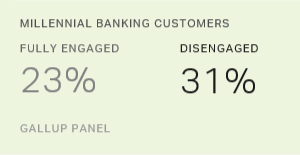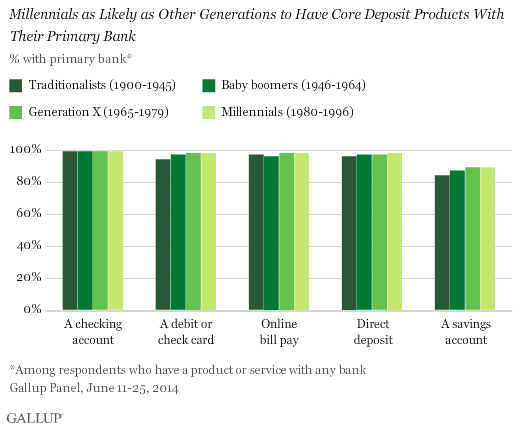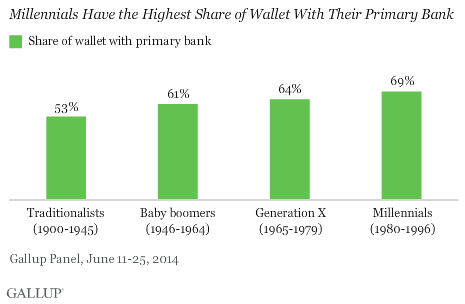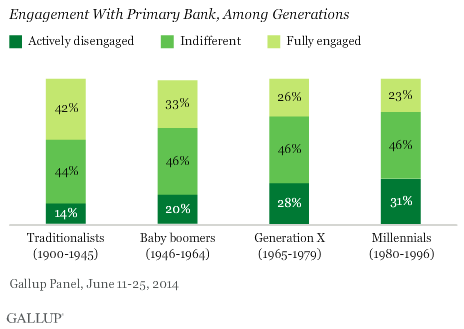Story Highlights
- Myths about millennial banking customers pose problems
- To banks, millennial customers are well worth the investment
- Data-driven strategies can help leaders engage millennials
It seems like everyone these days has an opinion about marketing to millennials. But financial leaders shouldn't believe everything they hear.
These views on marketing to those born from 1980 to 1996 have produced several myths about the behaviors of millennial banking customers that empirical data don't necessarily support. False assumptions about millennials -- for example, that they have low personal assets -- can pose problems for financial leaders as they seek to engage all their customers.
As the millennial customer base grows, misunderstanding or disregarding millennials could cause leaders to lose these customers or miss the benefits of engaging them. To engage millennials and invest in this expanding customer group, leaders should sort myths from facts and take action based on empirical data.

Myth: Millennials shop around and don't have all their financial products or services with one firm.
Reality: Millennial banking customers are just as likely as members of older generations to use nearly every core deposit product with their primary bank: a checking account, a debit or check card, online bill pay, direct deposit and a savings account.

Millennials are also more likely than Generation X customers (born from 1965 to 1979) to have each of the following with their primary bank: a home equity loan or line of credit; a credit card; financial planning or advisory services; a home mortgage loan; and an auto, boat or recreational vehicle loan.
Millennials can bring a lot to the table -- and they do have all their financial products and services with their primary bank. For bank leaders, this makes attracting and engaging millennial customers a smart investment.
Myth: Millennials have low personal assets, so they're not worth engaging.
Reality: There are some millennials with money. Fourteen percent of millennials have more than $100,000 in investable assets and 10% have $50,000 to $100,000. Nearly three in 10 millennials (27%) have $10,000 to $50,000 in total deposits with the banks they do business with.
What's more, Gallup recently found that millennials have a higher share of wallet with their primary bank than any other generation. And when banks engage millennials, they gain a serious boost in wallet share: Fully engaged millennials have a 23% greater share of wallet than actively disengaged millennials. This boost in wallet share is significantly higher than the 13% of Gen X and 17% of baby boomer (born from 1946 to 1964) customers.

Financial leaders who believe that millennials' assets are too low to invest in their engagement are relying on a faulty assertion. The truth is that millennials have a lot to offer financially.
Fact: Banks are doing a bad job at engaging millennials.
Unfortunately, Gallup's research supports the notion that banks aren't great at engaging millennials. Only 23% of millennials are fully engaged with their primary bank, while 31% are actively disengaged, making millennials the least engaged generation. Considering that fully engaged customers bring considerable benefits to their banks -- including 37% higher annual revenue than actively disengaged customers -- this is a big problem for financial leaders.

When it comes to customer experiences, millennials report the most problems and are the generation least likely to have their problems resolved. Though they use more banking channels than any other generations, millennials also have fewer satisfying interactions with their banks than baby boomer and traditionalist (born 1900 to 1945) customers.
Finally, millennials are the generation least likely to strongly agree that their bank has their best interests at heart, helps them reach their financial goals or looks out for their financial well-being. There's no denying it: Banks need to do a better job of satisfying their millennial customers.
The good news is there are research-backed strategies that leaders can employ to better serve and engage banking customers. Here are three:
Make customers' financial well-being a high priority. When customers strongly agree that their bank looks out for their financial well-being, 84% are fully engaged, while none are actively disengaged. Millennials are an attractive target for financial well-being efforts because of their age and life stage and because so few believe that their banks are helping them.
Manage customer problems and resolve them quickly. Though many banks have taken a serious look at their customer complaint procedures in recent years, millennials' needs are still going unresolved. Banks should look closer at their customer complaints data to determine which problems affect millennial customers most often, and then evaluate their policies and procedures to correct them.
Deliver the convenience of multiple channels while maintaining consistently positive experiences across every channel. Fifty-five percent of customers who are perfectly satisfied with all channels they use are fully engaged, but if they give a less-than-perfect satisfaction score to even one channel, their engagement drops by 40 percentage points to 15%. This problem particularly affects millennial customers, who use more channels than any other generation and, therefore, have a higher likelihood of disappointing interactions with their bank.
Awareness about opportunities to engage millennials is step one; making the right strategic moves to invest in these customers is step two. For leaders in the financial services industry, the payoff for engaging and investing in millennial customers is substantial -- and even greater than some believe.
Survey Methods
Results are based on a Gallup Panel Web study completed by 20,521 national adults, aged 18 and older, conducted June 11-25, 2014. The Gallup Panel is a probability-based longitudinal panel of U.S. adults whom Gallup selects using random-digit-dial phone interviews that cover landlines and cellphones. Gallup also uses address-based sampling methods to recruit Panel members. The Gallup Panel is not an opt-in panel, and Panel members do not receive incentives for participating. The sample for this study was weighted to be demographically representative of the U.S. adult population using the most recent Current Population Survey figures. For results based on this sample, one can say that the maximum margin of sampling error is ±1 percentage point at the 95% confidence level. Margins of error are higher for subsamples. In addition to sampling error, question wording and practical difficulties in conducting surveys can introduce error or bias into the findings of public opinion polls.

